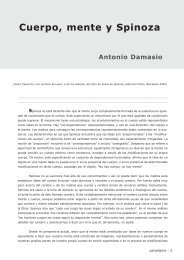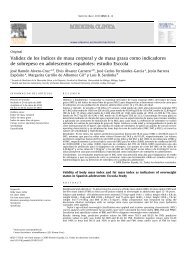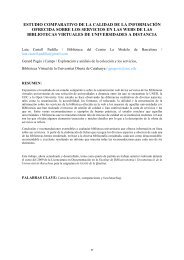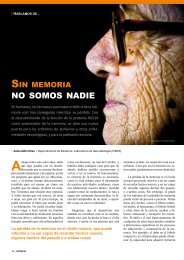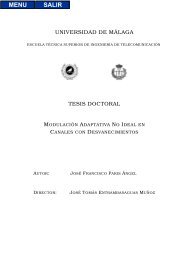Estereotipos negativos hacia la vejez y su relación con variables ...
Estereotipos negativos hacia la vejez y su relación con variables ...
Estereotipos negativos hacia la vejez y su relación con variables ...
You also want an ePaper? Increase the reach of your titles
YUMPU automatically turns print PDFs into web optimized ePapers that Google loves.
Referencias<br />
Morgan, T. et al. (1984). Old age and environmental docility: The roles of health, <strong>su</strong>pport and<br />
personality. Journal of Gerontology, 39(2), 240-242.<br />
Morganti, J. B., Nehrke, M .F., Hulicka, I. M. y Cataldo, J. F. (1988). Life- span Differences in life<br />
satisfaction, self-<strong>con</strong>cept, and locus of <strong>con</strong>trol. International Journal of Aging and Human<br />
Development, 26(1), 45-56.<br />
Morrissey, S. (1998). Resources and characteristics of elderly women who live alone. Health Care for<br />
Women International, 19 (5), 411-421.<br />
Mowery, D. C. y Kamlet, M. S. (1993). New technologies and the aging work force. En S. A. Bess, F.<br />
G. Caro y Y. P. Chen (Eds.), Achieving a productive aging society (pp. 81-95). Westport, CT:<br />
Auburn House.<br />
Mroczek, D., Spiro. A., Adwin, C., Ozer, D. y Bossé (1993). Construct validation of optimism and<br />
pessimism in older men: Findings from the normative aging study. Health Psychology, 12(5),<br />
406-409.<br />
Mroczek, D. y Ko<strong>la</strong>rz, C. M. (1998). The effect of age on positive and negative affect: A<br />
developmental perspective on happiness. Journal of Personality and Social Psychology, 75,<br />
1333-1349.<br />
Muchinik, E. (1993). Las redes sociales de apoyo: ¿podemos re<strong>con</strong>struir <strong>la</strong> comunidad? Revista<br />
Argentina de Clínica Psicológica, 2(2), 174-182.<br />
Mullins, L., Johnson, D. y Anderson, L. (1988). Loneliness of the elderly: The impact of family and<br />
friends. Journal of Social Behavior and Personality, 2(2,Pt 2), 225-238.<br />
Murphy, S. T. Monahan, J. L. y Zajonc, R. B. (1995). Additivity of non<strong>con</strong>sious affect: Combined<br />
effects of priming and expo<strong>su</strong>re. Journal of Personality and Social Psycology, 69, 589-602.<br />
Nakanishi, N., Tatara, K. et al. (1998). Re<strong>la</strong>tionships of disability, health management and<br />
psychosocial <strong>con</strong>ditions to cause-specific mortality among a community residing elderly<br />
people. Journal of epidemiology Japan Epidemiological Association, 8(4),195-202.<br />
Nakanishi, N. et al. (1998). Mortality in re<strong>la</strong>tion to the type of household among elderly people living<br />
in a community. Journal of epidemiology Japan Epidemiological Association, 8(1),65-72.<br />
Namkee, G. Choi, P. D. y Schlichting-Ray, M. (2001). Predictors of transitions in Disease and<br />
Disability in Pre- and Early- Retirement Popu<strong>la</strong>tions. Journal of Aging And Health, 13(3),<br />
379-409.<br />
Navarro, M. J. (1999). El tabú de <strong>la</strong> <strong>vejez</strong>. En S. Yubero, M. D. Latorre, J. Montañés y E. Larrañaga<br />
(Coord.). Envejecimiento, sociedad y salud (pp. 163-179). Cuenca: Universidad de Castil<strong>la</strong>-La<br />
Mancha.<br />
Naylor, C. et al. (2003). Daily social and physical activity increases slow-wave sep and daytime<br />
neuropsychological performance in the elderly. Journal of Sleep Research and Sleep<br />
Medicine, 23(1), 87-95.<br />
241




